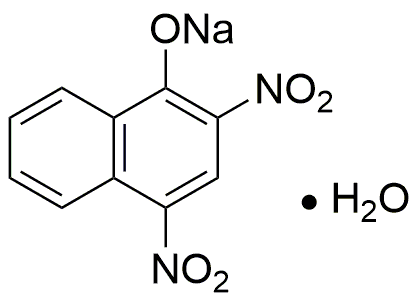Martius Yellow sodium salt monohydrate is widely utilized in research focused on:
- Dyes and Pigments: This compound serves as a vibrant dye in textiles and paper industries, providing excellent colorfastness and stability compared to other dyes.
- Biological Staining: In laboratory settings, it is used for staining biological samples, enhancing visibility of cellular structures under a microscope, which is crucial for histological studies.
- Analytical Chemistry: It acts as a reagent in various analytical methods, aiding in the detection and quantification of specific compounds, thus improving accuracy in chemical analysis.
- Environmental Monitoring: The compound is applied in assessing water quality by detecting pollutants, making it valuable for environmental scientists and regulatory agencies.
- Research in Organic Chemistry: It is utilized in synthetic pathways for creating complex organic molecules, offering a versatile tool for chemists in developing new compounds.
General Information
Properties
Safety and Regulations
Applications
Martius Yellow sodium salt monohydrate is widely utilized in research focused on:
- Dyes and Pigments: This compound serves as a vibrant dye in textiles and paper industries, providing excellent colorfastness and stability compared to other dyes.
- Biological Staining: In laboratory settings, it is used for staining biological samples, enhancing visibility of cellular structures under a microscope, which is crucial for histological studies.
- Analytical Chemistry: It acts as a reagent in various analytical methods, aiding in the detection and quantification of specific compounds, thus improving accuracy in chemical analysis.
- Environmental Monitoring: The compound is applied in assessing water quality by detecting pollutants, making it valuable for environmental scientists and regulatory agencies.
- Research in Organic Chemistry: It is utilized in synthetic pathways for creating complex organic molecules, offering a versatile tool for chemists in developing new compounds.
Documents
Safety Data Sheets (SDS)
The SDS provides comprehensive safety information on handling, storage, and disposal of the product.
Product Specification (PS)
The PS provides a comprehensive breakdown of the product’s properties, including chemical composition, physical state, purity, and storage requirements. It also details acceptable quality ranges and the product's intended applications.
Certificates of Analysis (COA)
Search for Certificates of Analysis (COA) by entering the products Lot Number. Lot and Batch Numbers can be found on a product’s label following the words ‘Lot’ or ‘Batch’.
*Catalog Number
*Lot Number
Certificates Of Origin (COO)
This COO confirms the country where the product was manufactured, and also details the materials and components used in it and whether it is derived from natural, synthetic, or other specific sources. This certificate may be required for customs, trade, and regulatory compliance.
*Catalog Number
*Lot Number
Safety Data Sheets (SDS)
The SDS provides comprehensive safety information on handling, storage, and disposal of the product.
DownloadProduct Specification (PS)
The PS provides a comprehensive breakdown of the product’s properties, including chemical composition, physical state, purity, and storage requirements. It also details acceptable quality ranges and the product's intended applications.
DownloadCertificates of Analysis (COA)
Search for Certificates of Analysis (COA) by entering the products Lot Number. Lot and Batch Numbers can be found on a product’s label following the words ‘Lot’ or ‘Batch’.
*Catalog Number
*Lot Number
Certificates Of Origin (COO)
This COO confirms the country where the product was manufactured, and also details the materials and components used in it and whether it is derived from natural, synthetic, or other specific sources. This certificate may be required for customs, trade, and regulatory compliance.


